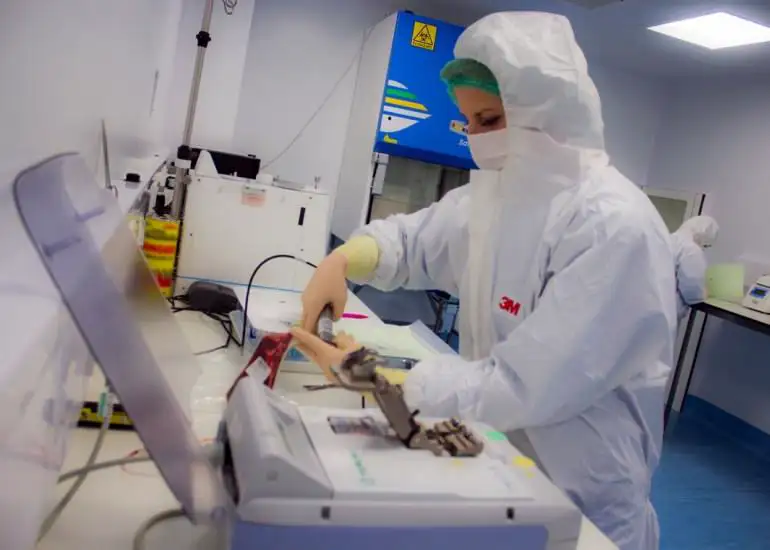Cord Blood Processing Facts
Cord Blood Processing Facts
A recent peer reviewed study published in the journal Laboratory Medicine by scientists at Stemlab/Famicord (Portugal) and Smart Cells International (SCI) has analysed three different cord blood processing methods and highlights one particularly effective method that has been developed by PBKM/Famicord.
The goal of this study was to compare a Manual HES processing method developed by PBKM/Famicord for extracting the stem cell rich fraction from cord blood to two automated processing methods (Sepax and AutoXpress (AXP). These three methods have been used to process 21,464 cord blood samples in the Stemlab laboratory in Portugal over the course of its 20 years of activity. This has generated a large database thus allowing the opportunity to retrospectively compare critical cell yields from each method used in a single laboratory.

SEPAX
AutoXpress (AXP)
Manual HES
Stem cell processing is a crucial part of the procedure for preserving stem cells for future medical needs. Cord blood, collected just after childbirth, is a rich source of certain types of therapeutically useful stem cells.
The findings from this unique analysis of processing methods were also compared to the published data in a report of a method of processing called TotiCyte.

What should parents be aware of?
The analysis shows that cord blood processing stem cell yields are very satisfactory and statistically equivalent for the Sepax, AXP and the Manual HES processing methods. Sepax and AXP are two globally trusted automated cord blood processing technologies (1-3) and the results of the Famicord/SCI study prove that the Manual HES method is equally effective.
All cord blood units are stored frozen after processing and stored in the cryopreserved state until they may be used clinically. It is therefore vital to ensure that after frozen storage and thawing, the stem cells are viable and capable of engrafting in patients. The analysis addressed this point by comparing the post freeze and thaw yields of TNCs and CD34+ stem cells after Manual HES processing with results published elsewhere for Toticyte. The paper clearly demonstrates that after processing, freezing and thawing the processed cord blood, the Manual HES method proved to be superior to TotiCyte technology with better recovery of total nucleated cells and equivalent yields of viable and functionally active CD34+ stem cells.

This research contradicts claims made by Cells4Life about the superiority of stem cell recovery from frozen cord blood following Toticyte processing. Cells4Life claims that their TotiCyte processing technology delivers 2-3x as many viable cells at the point of therapy. The findings from our study demonstrate that the Manual HES method is in fact superior from the medical application perspective with higher post-thaw yields of TNC and equivalent levels of CD34+ cell recovery and functionality.
A recent article from the British Medical Journal (BMJ) has also cast doubt over Cells4Life’s Toticyte technology. Notably, the BMJ has stated:

The above points are noteworthy for expectant parents to be aware of as Cells4Life’s method of marketing using misleading claims about their stem cell extraction technology has thrown an unfavourable light over the cord blood banking industry. Our key values at Smart Cells include transparency to our clients and prospective clients as well as upholding the highest possible industry standards by utilising reputable and validated techniques.
Global patient transplant success rates over two decades provides robust reassurance that Sepax, AXP and the Manual HES methods are all high quality and reliable techniques. This is borne out by the fact that cord blood units processed using all these methods then subsequently frozen, stored and thawed have been successfully used clinically in transplant centres to treat patients.
Why is this research important for families?
When choosing a cord blood collection company, families should be privy to all the most up to date information and research on stem cell banking. There are several questions that parents may ask to help them determine which cord blood banking company is the right one for them such as what the cord blood collection process looks like and how easily they might be able to access it in future. However, there are some aspects of the process that sometimes go under the radar which are just as important for families to know about. The processing of the cord blood to yield viable stem cells and prepare them for long term frozen storage are crucial aspects of the entire process.
Knowing that your baby’s precious cord blood is being processed using validated and up to date methods is important as this offers the best chance to have a quality stem cell product available to use should you require it in future.
It is essential to know that the cord blood company you are choosing to bank your child’s stem cells with is reputable and is one which considers all the potential methods of collection and processing to select the best one(s) for families. Making false claims that a method is superior when it achieves equivalent or inferior results may be a reason for families to reconsider their trust in a company. When choosing a cord blood bank, it is important to consider evidence-based practices.
References:
1. https://www.ncbi.nlm.nih.gov/pmc/articles/PMC3729132/
2. https://www.astctjournal.org/article/S1083-8791(15)01660-2/fulltext
3. https://bmt.confex.com/tandem/2018/meetingapp.cgi/Paper/11529
If you would like more information on cord blood collection or the processes that your child’s cord blood will go through once it has been collected, please do get in touch to find out more. We would be happy to chat you through every stage of the process.


